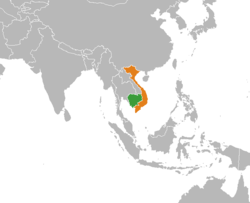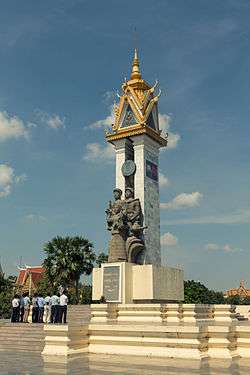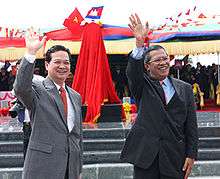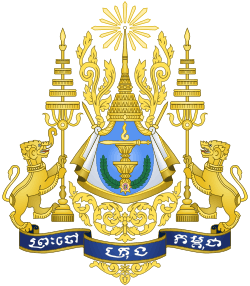Cambodia–Vietnam relations
Cambodia–Vietnam relations take place in the form of bilateral relations between the Kingdom of Cambodia and the Socialist Republic of Vietnam. The countries have shared a land border for the last 1,000 years and share more recent historical links through being part of the French colonial empire. Both countries are members of the Association of Southeast Asian Nations (ASEAN).
 | |
Cambodia |
Vietnam |
|---|---|
History
Early history
Both the Vietnamese and the Khmer (Cambodian) peoples descended from ancient Austroasiatic-speaking peoples who settled throughout the eastern and southeastern regions of Indochina. Vietnamese society, which began in the Red River Delta south of China, was heavily Sinicized while Khmer society, which was centered around the lower reaches of the Mekong river, was Indianized. During these early periods, the various polities of the two societies did not share a common border.[1] Territorial expansions eventually resulted in the spheres of influence of the growing Vietnamese Dai Viet and the large, well-established Khmer Empire overlapping in the 11th century, leading to centuries of friction and conflict. In the early 12th century, the Lý Dynasty successfully repelled an invasion by the Khmer king Suryavarman II.[2]
Much of Vietnam's southward territorial expansion started by the Lý Dynasty and expanded by the Trần Dynasty from the 14th century onward came at the expense of Champa which became an increasingly compressed polity. By the 17th century, the Vietnamese military commander government Nguyễn lords encouraged settlers to push into Khmer territories, eventually wresting the Mekong Delta from the Cambodian court.[1] Today, Cambodia shares a 1,137 kilometres long border with Vietnam in the east and southeast.[3]
After the Cambodian–Dutch War, a Buddhist Cambodian king who had converted to Islam was ousted and arrested by the Vietnamese Nguyen lords after Ibrahim's brothers, who remained Buddhists, requested Vietnamese help to restore Buddhism to Cambodia by removing him from the throne.[4]
The 16th and 17th centuries marked the height of the Kinh people's (ethnic Vietnamese) penetration into the southern Mekong Delta, displacing the Khmers.[5] Military campaigns by Nguyen Phuoc Yen opened up more Khmer land for Vietnamese settlement which was followed by Nguyen Phuoc Lam's consolidation of Vietnamese control over the Prey Nokor (later Saigon) region in 1674. Both Mesa (modern Mỹ Tho) and Longhor (modern Vĩnh Long) fell to the Vietnamese by 1732. Nguyen Thien Chinh's and Nguyen Cu Trinh's armies in the 1750s took control of Mekong estuaries, cutting off Cambodia's riverine access to the sea.[1] The Vietnamese presence was bolstered following the Qing conquest of the Ming (1618-1683) when groups of Ming loyalist refugees came to the region seeking the protection of the Nguyễn lords. Those led by Mạc Cửu (1655-1735) helped settle Hà Tiên while others flocked to Bien Hoa and My Tho, pushing out the Khmers.[1] By 1775, the Cambodian court had ceded the areas of Praah-Trapeng (Trà Vinh), Srok Trang (Sóc Trăng), and Meat Chruk (An Giang) to the Vietnamese without bloodshed.[1]
With the rise of the Nguyễn Dynasty in the early 19th century, southern Vietnam came under tighter control of the court. The Vietnamese emperor Minh Mạng (1820–41) took the paternalistic views that the Khmers were backward and ordered his general Trương Minh Giảng to "civilize" the "barbarian" Cambodians. Cambodia itself was brought under Vietnamese control with the occupation of Phnom Penh. Truong reported: "we have decided that Cambodian officials only know how to bribe and be bribed. Offices are sold. Nobody carries out orders; everyone works for his own account".[5] A policy of cultural Vietnamization ("Nhat Thi Dong Nhan") was imposed, forcing Khmers to adopt Vietnamese attire, names, and language.[1] State-encouraged Vietnamese settlement in Phnom Penh ("Tran Tay") accelerated, and Vietnamese occupying forces spirited away native Cambodian leaders like Ang Mey to inland Vietnam in order to weaken Khmer resistance. However, Khmer uprisings in southern Vietnam from 1840 to 1845 made this policy of direct rule inconvenient and expensive for the Vietnamese court, which opted to keep Cambodia as a tributary state after the death of Minh Mang.[1]
After the Siamese–Vietnamese Wars, first in the 1830s and then a decade later, Cambodia became a vassal state under Vietnam and Siam, with the country becoming culturally and administratively Vietnamized. In 1863, the Thai-raised King Norodom of Cambodia (reign 1860-1904) signed a treaty with the French Empire, granting the latter mineral exploration rights if it would secure the country against Thai and Vietnamese attack.[5] However, during the colonial rule of French Indochina, which would later come to include Vietnam, French authorities imported Vietnamese laborers to Cambodia, where the growing minority came to dominate businesses and water resources in the country. In the First Indochina War for independence, some Cambodians, including King Norodom Sihanouk, fought against Viet Minh forces because they feared Vietnamese colonial domination.[6]
Vietnam War
After independence, the Kingdom of Cambodia maintained diplomatic relations with both North Vietnam and South Vietnam. However the Vietnamese Communists, both the southern Viet Cong and the northern People's Army of Vietnam, used Cambodian territory for bases and supply routes to fight the Vietnam War, despite the Viet Minh having previously assured Cambodian neutrality at the 1954 Geneva Conference. The southern Ngo Dinh Diem administration pursued Viet Cong even into Cambodian territory.[6] Earlier in the Bangkok Plot of 1959, the Diem administration supported a plot by politicians Sam Sary, Son Ngoc Thanh, and Dap Chhuon to overthrow Sinahouk's government and replace it with a right-wing pro-southern regime.[7] Despite Sinahouk's attempts to stay on Hanoi's good side and turning a blind eye to PAVN bases in his country, the PAVN also armed and sheltered the anti-government insurgency known as the Khmer Rouge starting in 1968.[8] By 1969, despite having previously adhered to Cambodian neutrality under Lyndon B. Johnson, the United States decided to bomb North Vietnamese and Viet Cong forces in the Cambodian borderlands during Operation Menu, as the PAVN was using it as a base to attack South Vietnam.
Despite attempts to negotiate with "whichever (Vietnamese state) will turn out to be most reasonable in... [demarcating] our common frontiers", Cambodian leader Norodom Sihanouk failed to get a hearing from a Vietnamese government about latent territorial disputes in Cochinchina and especially Phú Quốc island. Sihanouk himself was accused of accommodating North Vietnamese military bases in Cambodia, and widespread anti-Vietnamese riots culminated in the National Assembly voting to depose Sihanouk in March 1970. Referring mainly to Viet Cong operating in the border region, the new Cambodian president Lon Nol declared that all Vietnamese troops in Cambodia must leave, to maintain the country's neutrality. The North Vietnamese responded to this request (as well as calls for aid from the Khmer Rouge) by invading Cambodia, quickly conquering over 40% of the country. They proceeded to hand over most of the territory they had gained to the Khmer Rouge, and drastically stepped up support for them; because of both this and the invasion, the Khmer Rouge quickly grew from a few thousand fighters to several tens of thousands in the span of two months.[9] American and South Vietnamese forces attempted to dislodge the PAVN soon after during the Cambodian campaign, but failed, despite inflicting heavy losses. Over the next five years, the Cambodian Civil War raged with the North Vietnamese and China backing the Khmer Rouge, while South Vietnam and the United States backed Lon Nol's newly-declared Khmer Republic. PAVN forces would engage Khmer Republic troops inside Cambodian borders many more times during this war in support of the Rouge, such as in Operation Chenla II.
The Khmer Rouge opposition came to power in Cambodia in 1975, shortly before the Fall of Saigon to Northern forces.[6]
Anti-Vietnamese sentiment was high in Cambodia during the Vietnam War; ethnic Vietnamese were slaughtered and dumped in the Mekong River at the hands of Lon Nol's anti-Communist forces.[10] The Khmer Rouge, despite being allied with North Vietnam, later imitated Lon Nol's actions.[11]
Cambodian-Vietnamese War

There have been many wars between Cambodia and Vietnam. In 1979, as a result of the Cambodian–Vietnamese War, Vietnam overthrew the Khmer Rouge and occupied Cambodia. Vietnamese occupying soldiers and journalists also discovered evidence of the Khmer Rouge's abuses, such as Tuol Sleng prison facility, and widely publicized them. The United States initially suspected the Vietnamese of falsifying this evidence, and warned them not to continue its army's march to Thailand, which they in fact did, in hot pursuit of the Khmer Rouge resistance.[5]
Recent events
In 2005, Vietnam and Cambodia signed a supplementary treaty to the original 1985 Treaty on Delimitation of National Boundaries, which Cambodia has deemed unacceptable. As a result, Vietnam has made several claims to Cambodian land based on the treaty that raised allegations of Vietnamese encroachment. In a statement made by a government minister of the former French Indochina colonial administration, Cambodia would have to give up two of its villages to Vietnam in return for keeping two villages Thlok Trach and Anlung Chrey, that were deemed Cambodian territory according to the 1985 treaty. It is not known which two villages Cambodia would have to give up. To resolve the dispute, in 2011, the Cambodian government announced it would speed the demarcation process with Vietnam.[12] On 24 June 2012, Vietnam and Cambodia celebrated the demarcation of the last marker on their shared border, marker 314. Prime Ministers Nguyen Tan Dung of Vietnam and Hun Sen of Cambodia personally attended the celebration to unveil the new marker and reaffirmed the two countries' cooperation and friendship.[13]
2014 anti-Vietnamese protests
Anti-Vietnamese protests have been ongoing since July 2014. Demonstrations have taken place after a statement by the Vietnamese embassy saying Kampuchea Krom has long been part of Vietnam. Protesters and activists demand the embassy to recognize Kampuchea Krom as Cambodia's former territory and for an apology. On 9 July, the embassy issued a statement calling for Cambodia to respect Vietnam's sovereignty and refused to apologize.[14] Among all protesters include the Khmer Krom community and Buddhist monks.[15] There has been burning of the Vietnamese flag and currency.[16] Vietnamese Prime Minister Nguyen Tan Dung called for Cambodia to take action against 'extremists' for the burning of the Vietnamese flag during National Assembly president Heng Samrin's state visit to Vietnam.[17] In October 2014, protesters threatened to burn the embassy itself. Protest leader Thach Setha prevented protesters from burning Vietnam's flag and one protester called him 'useless'.[18]
Anti-Vietnamese sentiment flaring in Cambodia in 2014 resulted in an ethnic Vietnamese man named Tran Van Chien getting beaten to death by a crowd of Cambodians resulting in fear among Vietnamese companies and investors in Cambodia.[19][20] Vietnamese businesses were ransacked and pillaged by Cambodians.[21] A mob of Cambodians killed another Vietnamese man named Nguyen Van Chyen.[22] Vietnamese workers were forced to flee as the businesses were looted. Cambodians have killed ethnic Vietnamese before during riots in the 1990s.[23] Tran's wife said that Tran Van Chien was murdered "like an animal" by the mob. Both the Lon Nol (anti-communist) and Khmer Rouge (communist) governments despised the Vietnamese.[24] A Vietnamese man named Nguyen Yaing Ngoc was killed by a Cambodian mob.[25]
The Cambodian word "Yuon" (yuôn) យួន /yuən/ is an ethnic slur for Vietnamese, derived from "Yavana", the Indian word for Greek.[26][27] It can also be spelled as "Youn".[28]
In a Koh Kong coastal island, Vietnamese were expelled by the government of Cambodia.[29]
Reasons behind anti-Vietnamese sentiments
Cambodian sentiment and antagonism against the Vietnamese run high, especially over border disputes and against Vietnamese illegal immigrants. Politicians use this feeling to gain support among Cambodian voters.[30] Due to its dominance during the 19th century, Vietnam regards Cambodia and Laos as vassal tributary states.[31]
The growing anti-Vietnamese sentiment in Cambodia is attributed to many factors. The recent anti-Vietnamese protests in Phnom Penh did not just happen out of thin air, nor was it a spontaneous grass-roots movement to force the Vietnamese government to respect Cambodia's sovereign territory. Time and time again throughout the history of Cambodia, the notion of foreigners allegedly encroaching on Khmer territory has been brought up by politicians in power, and those hoping to grasp power in the country. The recent protests, demanding for an apology from Vietnam and the acknowledgement that Kampuchea Krom was formerly Khmer territory.
Previous examples include the riots after the 2013 national election, which was allegedly "marred by irregularities, intimidation of members and leaders of the opposition parties".[32] Protestors not only claimed to have been "cheated" in the election, allegations of Vietnamese nationals being brought in from Vietnam to vote in their place were brought up. This trend of accusing Vietnamese involvement is quite common regardless of how well the theory holds up to scrutiny. While there has been a lot of antagonism from the Khmer people toward Vietnam, it is very rare for the Vietnamese to reciprocate the sentiment. However a few days before Cambodia's national election, "Nguyen Chi Dzung, head of citizen protection and legal affairs of the embassy's consular section of Vietnam", criticized Sam Rainsy, the opposition party leader, for "capitalizing on the ethnic issue for political gains".[33]
Undeniably, there has been a very long history of distrust towards the Vietnamese amongst the Khmers. The issue with the territory of Kampuchea Krom stems to the colonial days of the two countries. "When France ceded Cochinchina to the new state of Vietnam in 1949, it attempted to resolve a territorial dispute in favor of the Vietnamese".[34] This resulted in a very large population of indigenous Khmer being under the control of Vietnam instead of Cambodia. Cambodia lost 89,000 km² of what it believes to be its territory. There have been examples of Khmer nationals referring to the Vietnamese as being devious and capable of savage acts. Some Khmer believe that "the ethnic Vietnamese would help Vietnam in its ongoing scheme to colonize Cambodia".[35]
Back to 2014, critics of the CNRP have argued that the party is using this inherent distrust toward the Vietnamese to gain political points. Sam Rainsy, the leader, have in the past used the Vietnamese as a vessel for blame concerning Cambodia's national issues; "while castigating Hun Sen and the CPP for being too close to anything Vietnamese and, thus, 'part of the problem.'"[36] The recent boom of anti-Vietnamese sentiments, then, is political as well as historical.
Extreme anti-Vietnamese sentiment due to Vietnam's conquest of previously Cambodian lands, Vietnamese settlers in Cambodia and Vietnam's military subjugation of Cambodia, has led to extreme anti-Vietnamese feelings against ethnic Vietnamese in Cambodia and against Vietnam, and in turn has led to pro-China sentiment among the Cambodian government and the Cambodian opposition, including in the South China Sea.[37] The desire for the retaking of Cambodian land is a factor in hostility against Vietnam. The Vietnamese received Cambodian land from the French which caused more hostile feeling towards the Vietnamese.[38] A large section of Cambodian society cutting across various classes and groups, including environmentalists and NGOS, are hostile to Vietnam and believe that the problems of Cambodia are caused by Vietnamese.[39]
A Cambodian Cham Muslim dissident, Hassan A Kasem, a former military helicopter pilot who was both persecuted and imprisoned by the Khmer Rouge and fought against Vietnamese invasion, denounced Vietnam as trying to position itself as the savior of Cambodia from Khmer Rouge rule. He wrote that Vietnam has deceived the west into thinking of it as a "magnanimous liberator" when it invaded Cambodia and ousted the Khmer Rouge when in fact Vietnam used the war to benefit its own interests, such as subjecting Cambodian financial assets and national treasures to pillaging and theft, settling border disputes to its own advantage, trying to destroy Cambodian nationalist feeling against Vietnam, benefiting from the mostly Khmer on Khmer violence by the Khmer Rouge, and setting up its own Communist puppet government to rule Cambodia with Vietnamese officials pretending to be Khmer.[40] The Cham activist organization "International Office of Champa" republished Hassan's article on their website Cham Today.[41]
Thai and Chinese are viewed much less negatively than the Vietnamese by the Khmer, mainly because Vietnam and Cambodia share little religious or cultural similarities and because Cambodian lands have been taken by the Vietnamese.[42]
Economic relations
Since the 1990s, relations between both nations have begun to improve. Both Vietnam and Cambodia are members of multilateral regional organizations such as ASEAN and the Mekong-Ganga Cooperation. Both nations have opened and developed cross-border trade and sought to relax visa regulations to that end.[3] Both governments have set official targets of increasing bilateral trade by 27% to US$2.3 billion by 2010 and to $6.5 billion by 2015.[3][43] Viet Nam exported US$1.2 billion worth of goods to Cambodia in 2007. While Cambodia is only the 16th largest importer of Vietnamese goods, Vietnam is Cambodia's third-largest export market.[3]
Diplomatic missions

- Cambodia has an embassy in Hanoi and a consulate-general in Ho Chi Minh City.
- Vietnam has an embassy in Phnom Penh and consulates-general in Battambang and in Sihanoukville.
References
- Thu-Hương Nguyễn-Võ (1992). Khmer-Viet relations and the third Indochina conflict. McFarland. pp. 1–2, 4–5, 9–15.
- Higham, C., 2001, The Civilization of Angkor, London: Weidenfeld & Nicolson, ISBN 9781842125847
- "Viet Nam-Cambodia trade set to increase 27%". Vietnam Business News. 18 January 2008. Archived from the original on 23 January 2008. Retrieved 11 June 2008.
- Ben Kiernan (2008). Blood and Soil: Modern Genocide 1500-2000. Melbourne Univ. Publishing. pp. 158–. ISBN 978-0-522-85477-0.
- Brinkley, Joel (2011). Cambodia's Curse: The Modern History of a Troubled Land. PublicAffairs. pp. 22–23, 25, 55–56.
- Pouvatchy, Joseph R. (April 1986). "Cambodian-Vietnamese Relations". Asian Survey. 26 (4): 440–451. doi:10.1525/as.1986.26.4.01p03736.
- Kiernan, B. How Pol Pot Came to Power
- Frey, Rebecca Joyce (2009). Genocide and International Justice. Infobase Publishing. pp. 266–67. ISBN 978-0816073108.
- "Victory in Vietnam: The Official History of the People's Army of Vietnam, 1954-1975." University Press of Kansas, May 2002 (original 1995). Translation by Merle L. Pribbenow. Pages 256-257.
- Ben Kiernan (2008). Blood and Soil: Modern Genocide 1500-2000. Melbourne Univ. Publishing. pp. 548–. ISBN 978-0-522-85477-0.
- Ben Kiernan (2008). Blood and Soil: Modern Genocide 1500-2000. Melbourne Univ. Publishing. pp. 554–. ISBN 978-0-522-85477-0.
- "Cambodia to cede two villages to Vietnam". The Phnom Penh Post. 18 June 2012. Retrieved 27 June 2012.
- "Key Viet Nam-Cambodia border marker inaugurated". Việt Nam News. 25 June 2012. Retrieved 27 June 2012.
- "វៀតណាមបដិសេធមិនសុំទោសរឿងបំភ្លៃប្រវត្តិសាស្ត្រខ្មែរកម្ពុជាក្រោម" (in Khmer). Radio Free Asia. 9 July 2014. Retrieved 7 October 2014.
- "Cambodia's ethnic Khmer Krom activists continue rally in front of Vietnamese Embassy". Global Post. 5 October 2014. Archived from the original on 5 October 2014. Retrieved 7 October 2014.
- "Cambodia Defends Flag Burning Protest as 'Freedom of Expression'". Radio Free Asia. 15 August 2014. Retrieved 7 October 2014.
- Mech, Dara (21 August 2014). "Official Rejects Vietnam's Reports of Punishment for Flag Burners". The Cambodia Daily. Retrieved 7 October 2014.
- Mech, Dara (7 October 2014). "Nationalists Renege on Threat to Burn Embassy". The Cambodia Daily. Retrieved 7 October 2014.
- Prak Chan Thul (28 April 2014). "Investors wary as anti-Vietnamese feeling grows in Cambodia". REUTERS. PHNOM PENH.
- "Anti-Vietnamese sentiment grows in Cambodia". The Straits Times Asia report. PHNOM PENH. 30 April 2014. Archived from the original on 17 June 2014. Retrieved 9 September 2016.
- Wallace, Julia; Vannarin, Neou (24 January 2014). "Cambodia protests unmask anti-Vietnam views". Al Jazeera. Phnom Penh.
- Oaten, James (10 July 2014). "Cambodian opposition leader accused of touting anti-Vietnamese racism". Newsline.
- Seiff, Abby; Vannarin, Neou (10 January 2014). "Anti-Vietnamese sentiment boils in Cambodia". Phnom Penh, Cambodia.
- Quinlan, Daniel; Asian Correspondent Staff (20 February 2014). "Cambodia mob killing highlights festering anti-Vietnamese sentiment". Asian Correspondent.
- Eang, Mengleng; Blomberg, Matt (18 February 2014). "Killing Reflects Danger of Anti-Vietnamese Sentiment". The Cambodia Daily.
- Post Staff (4 July 2003). "From Ionia to Vietnam". The Phnom Penh Post.
- "Archived copy". Archived from the original on 10 August 2016. Retrieved 9 August 2016.CS1 maint: archived copy as title (link)
- "Pejorative Terms "Yuon" and "Mien"". University Libraries University of Washington. Vietnam Studies Group. 2008. Archived from the original on 21 March 2014.
- http://www.bangkokpost.com/news/asean/525063/vietnamese-monks-evicted-from-cambodia-island-shrines-burned http://defence.pk/threads/cambodian-navy-evicts-vietnamese-monks-and-destroys-illegal-shrines-on-island.370263/
- Chheang, Vannarith (16 October 2015). "How Cambodian nationalism is driving border disputes with Vietnam". East Asia Forum.
- "Laos and Cambodia". Country Studies. U.S. Library of Congress.
- Um, Khatharya (2014). "Cambodia in 2013: The Winds of Change". Southeast Asian Affairs. 2014: 97–116.
- Khy, Sovuthy. "Vietnamese Embassy Official Criticizes CNRP's Racial Rhetoric". www.cambodiadaily.com. The Cambodian Daily. Retrieved 29 October 2014.
- McHale, Shawn (2013). "Ethnicity, violence, and khmer-vietnamese relations: The significance of the lower mekong delta, 1757–1954". The Journal of Asian Studies. 72 (2): 367. doi:10.1017/s0021911813000016.
- Berman, Jennifer S. (1996). "No place like home: Anti-vietnamese discrimination and nationality in cambodia". California Law Review. 84 (3): 817–874. doi:10.2307/3480966. JSTOR 3480966.
- Chea, Sotheacheath; Woodley, Dan. "Vietnam: The view from Cambodia". www.phnompenhpost.com. Phnom Penh Post. Retrieved 29 October 2014.
- Greer, Tanner (5 January 2017). "Cambodia Wants China as Its Neighborhood Bully". Foreign Policy.
- Hutt, David (20 October 2016). "The Truth About Anti-Vietnam Sentiment in Cambodia". The Diplomat.
- Frewer, Tim (6 September 2016). "Cambodia's Anti-Vietnam Obsession". The Diplomat.
- Kasem, Hassan A (9 October 2013). "Vietnam's hidden hand in Cambodia's impasse". Asia Times.
- Kasem, Hassan A. "Vietnam's hidden hand in Cambodia's impasse". IOC-Champa. Archived from the original on 30 June 2015. Retrieved 9 February 2017.
- "Cambodia - Vietnam Relations". Global Security.
- "Cambodia, Viet Nam target $2.3 billion in bilateral trade by 2010". Vietnam News. 21 January 2008. Retrieved 11 June 2008.


